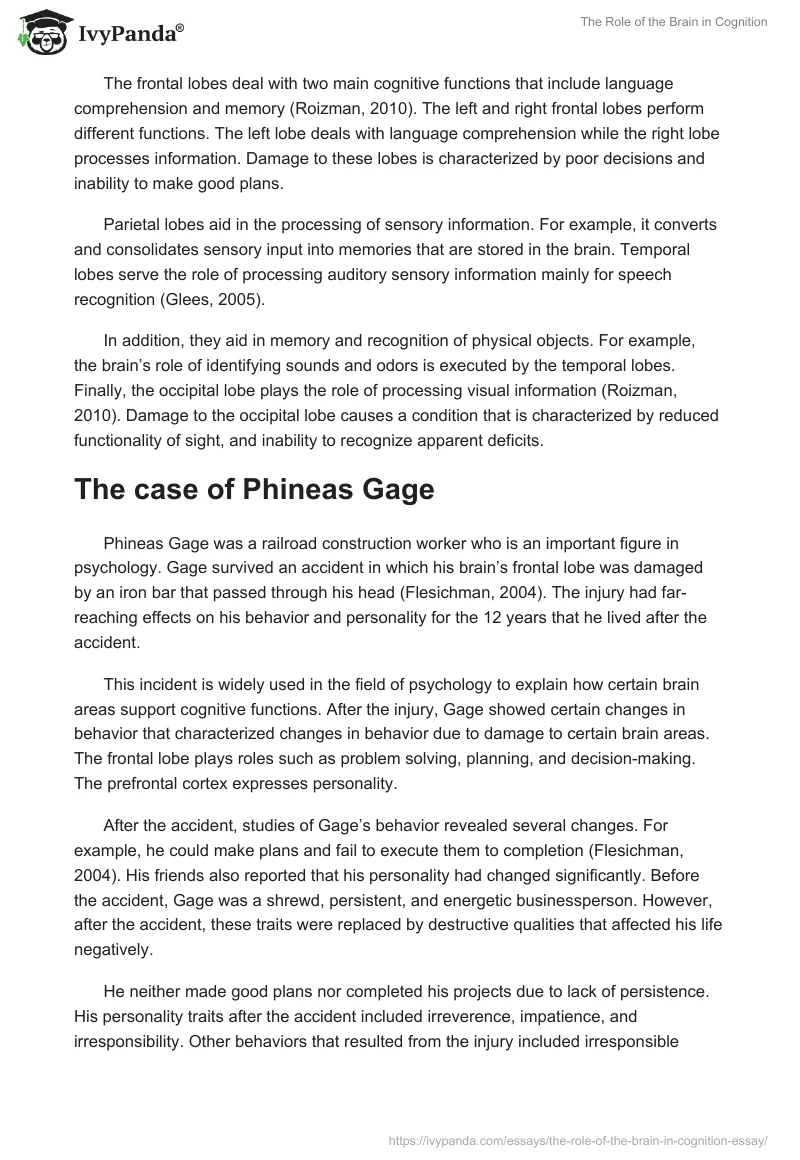Introduction
Cognition refers to the process through which information is processed, stored, and recovered for use (Glees, 2005). This process involves several mental processes that play different roles in order to enhance functions such as memory, comprehension, learning, problem solving, thinking, and decision making. The brain plays a pivotal role in cognition.
It is a faculty that helps to process sensory information, apply knowledge, and make important decisions (Glees, 2005). Cognition comprises mental functions and processes, as well as intelligent entities. The brain uses its various parts to process information.
For example, certain parts are concerned with memory while other parts deal with learning. The case of Phineas Gage is widely used to demonstrate the role of the brain in cognition. His brain injury is used in the field of psychology to understand and explain the functioning of the human brain with regard to cognition.
Role of the brain in cognition
The brain plays a pivotal role in supporting cognitive functions. Examples of cognitive functions include learning, memory, and perception (Glees, 2005). The brain has several parts that play different roles in the execution of cognitive functions. Parts of the brain involved in cognition include prefrontal cortex, frontal and parietal lobes, temporal lobes, and occipital lobe (Roizman, 2010).
The prefrontal cortex is the latest part of the brain to be discovered in the field of psychology. It executes high-priority cognitive functions that include planning, assessment of the outcomes of actions, and expression of personality traits (Roizman, 2010). In addition, this area expresses the aptness of various behaviors in different social contexts.
The frontal lobes deal with two main cognitive functions that include language comprehension and memory (Roizman, 2010). The left and right frontal lobes perform different functions. The left lobe deals with language comprehension while the right lobe processes information. Damage to these lobes is characterized by poor decisions and inability to make good plans.
Parietal lobes aid in the processing of sensory information. For example, it converts and consolidates sensory input into memories that are stored in the brain. Temporal lobes serve the role of processing auditory sensory information mainly for speech recognition (Glees, 2005).
In addition, they aid in memory and recognition of physical objects. For example, the brain’s role of identifying sounds and odors is executed by the temporal lobes. Finally, the occipital lobe plays the role of processing visual information (Roizman, 2010). Damage to the occipital lobe causes a condition that is characterized by reduced functionality of sight, and inability to recognize apparent deficits.
The case of Phineas Gage
Phineas Gage was a railroad construction worker who is an important figure in psychology. Gage survived an accident in which his brain’s frontal lobe was damaged by an iron bar that passed through his head (Flesichman, 2004). The injury had far-reaching effects on his behavior and personality for the 12 years that he lived after the accident.
This incident is widely used in the field of psychology to explain how certain brain areas support cognitive functions. After the injury, Gage showed certain changes in behavior that characterized changes in behavior due to damage to certain brain areas. The frontal lobe plays roles such as problem solving, planning, and decision-making. The prefrontal cortex expresses personality.
After the accident, studies of Gage’s behavior revealed several changes. For example, he could make plans and fail to execute them to completion (Flesichman, 2004). His friends also reported that his personality had changed significantly. Before the accident, Gage was a shrewd, persistent, and energetic businessperson. However, after the accident, these traits were replaced by destructive qualities that affected his life negatively.
He neither made good plans nor completed his projects due to lack of persistence. His personality traits after the accident included irreverence, impatience, and irresponsibility. Other behaviors that resulted from the injury included irresponsible sexual behavior, domestic violence against his wife and children, lying, gambling, bullying, and lack of foresight (Flesichman, 2004).
These behaviors mainly resulted from poor judgment and planning. One of the most common signs of frontal lobe damage is change in behavior. An individual who suffers damage to their frontal lobes does not behave as they used to before the damage.
People who are close to the individual can observe these changes in behavior. After the accident, Gage showed a decrease in the efficiency of functions that included planning, judgment, inhibition, and decision making (Flesichman, 2004).
Conclusion
The brain serves several roles, one of which is supporting cognitive functions. Parts of the brain that support cognition include prefrontal cortex, frontal and parietal lobes, temporal lobes, and occipital lobe. Each of these parts performs a different role. Examples of cognitive functions performed by these parts include judgment, memory, and decision-making, problem solving, and planning.
The brain injury of Phineas Gage is used by psychologists to demonstrate the role of the brain with regard to cognition. After the accident, Gage’s personality changed tremendously after damage to his brain’s frontal lobe. Behavioral changes included irresponsible sexual behavior, domestic violence against his wife and children, lying, gambling, bullying, and lack of foresight.
References
Flesichman, J. (2004). Phineas Gage: A Gruesome but True Story about Brain Science. New York: Houghton Mifflin Harcourt.
Glees, P. (2005). The Human Brain. London: Cambridge University Press.
Roizman, T. (2010). The Brain Functions Involved in Cognitive Functions. Web.


